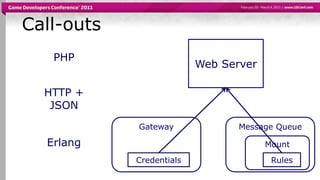Ad
Message Queuing on a Large Scale: IMVUs stateful real-time message queue for chat and games
- 1. Large-scale Messaging at IMVUJon WatteTechnical Director, IMVU Inc@jwatte
- 2. Presentation OverviewDescribe the problemLow-latency game messaging and state distributionSurvey available solutionsQuick mention of also-ransDive into implementationErlang!Discuss gotchasSpeculate about the future
- 3. From Chat to Games
- 4. ContextCachingWeb ServersHTTPLoad BalancersDatabasesCachingLong PollLoad BalancersGame ServersHTTP
- 5. What Do We Want?Any-to-any messaging with ad-hoc structureChat; Events; Input/ControlLightweight (in-RAM) state maintenanceScores; Dice; Equipment
- 6. New Building BlocksQueues provide a sane view of distributed state for developers building gamesTwo kinds of messaging:Events (edge triggered, “messages”)State (level triggered, “updates”)Integrated into a bigger system
- 7. From Long-poll to Real-timeCachingWeb ServersLoad BalancersDatabasesCachingLong PollLoad BalancersGame ServersConnection GatewaysMessage QueuesToday’s Talk
- 8. FunctionsGame ServerHTTPValidation users/requestsNotificationClientConnectListen message/state/userSend message/stateCreate/delete queue/mountJoin/remove userSend message/stateQueue
- 9. Performance RequirementsSimultaneous user count:80,000 when we started150,000 today1,000,000 design goalReal-time performance (the main driving requirement)Lower than 100ms end-to-end through the systemQueue creates and join/leaves (kill a lot of contenders)>500,000 creates/day when started>20,000,000 creates/day design goal
- 10. Also-rans: Existing WheelsAMQP, JMS: Qpid, Rabbit, ZeroMQ, BEA, IBM etcPoor user and authentication modelExpensive queuesIRCSpanning Tree; Netsplits; no stateXMPP / JabberProtocol doesn’t scale in federationGtalk, AIM, MSN Msgr, Yahoo MsgrIf only we could buy one of these!
- 11. Our Wheel is Rounder!Inspired by the 1,000,000-user mochiweb apphttp://www.metabrew.com/article/a-million-user-comet-application-with-mochiweb-part-1A purpose-built general systemWritten in Erlang
- 12. Section: ImplementationJourney of a messageAnatomy of a queueScaling across machinesErlang
- 13. The Journey of a Message
- 14. Queue NodeGatewayThe Journey of a MessageGateway for UserQueue NodeQueue ProcessMessage in Queue: /room/123Mount: chatData: Hello, World!Find node for /room/123Find queue /room/123List of subscribersGatewayValidationGatewayGateway for UserForward message
- 15. Anatomy of a QueueQueue Name: /room/123MountType: messageName: chatUser A: I win.User B: OMG Pwnies!User A: Take that!…Subscriber ListUser A @ Gateway CUser B @ Gateway BMountType: stateName: scoresUser A: 3220 User B: 1200
- 16. A Single Machine Isn’t Enough1,000,000 users, 1 machine?25 GB/s memory bus40 GB memory (40 kB/user)Touched twice per messageone message per is 3,400 ms
- 17. Scale Across MachinesGatewayQueuesGatewayQueuesInternetGatewayQueuesConsistent HashingGatewayQueues
- 18. Consistent HashingThe Gateway maps queue name -> nodeThis is done using a fixed hash functionA prefix of the output bits of the hash function is used as a look-up into a table, with a minimum of 8 buckets per nodeLoad differential is 8:9 or better (down to 15:16)Updating the map of buckets -> nodes is managed centrallyHash(“/room/123”) = 0xaf5…Node ANode BNode CNode DNode ENode F
- 19. Consistent Hash Table UpdateMinimizes amount of traffic movedIf nodes have more than 8 buckets, steal 1/N of all buckets from those with the most and assign to new targetIf not, split each bucket, then steal 1/N of all buckets and assign to new target
- 20. ErlangDeveloped in ‘80s by Ericsson for phone switchesReliability, scalability, and communicationsProlog-based functional syntax (no braces!)25% the code of equivalent C++Parallel Communicating ProcessesErlang processes much cheaper than C++ threads(Almost) No Mutable DataNo data race conditionsEach process separately garbage collected
- 21. Example Erlang Process% spawn processMyCounter = spawn(my_module, counter, [0]).% increment counterMyCounter! {add, 1}.% get valueMyCounter! {get, self()};receive {value, MyCounter, Value} -> Valueend.% stop processMyCounter! stop.counter(stop) -> stopped;counter(Value) ->NextValue = receive {get, Pid} ->Pid! {value, self(), Value}, Value; {add, Delta} -> Value + Delta; stop -> stop; _ -> Valueend, counter(NextValue). % tail recursion
- 22. Section: DetailsLoad ManagementMarshallingRPC / Call-outsHot Adds and Fail-overThe Boss!Monitoring
- 24. Marshallingmessage MsgG2cResult { required uint32 op_id = 1; required uint32 status = 2; optional string error_message = 3;}
- 25. RPCWeb ServerPHPHTTP + JSONadminGatewayMessage QueueErlang
- 26. Call-outsWeb ServerPHPHTTP + JSONMessage QueueGatewayErlangMountCredentialsRules
- 28. MonitoringExample counters:Number of connected usersNumber of queuesMessages routed per secondRound trip time for routed messagesDistributed clock work-around!Disconnects and other error events
- 29. Hot Add Node
- 30. Section: Problem CasesUser goes silentSecond user connectionNode crashesGateway crashesReliable messagesFirewallsBuild and test
- 31. User Goes SilentSome TCP connections will stop(bad WiFi, firewalls, etc)We use a ping messageBoth ends separately detect ping failureThis means one end detects it before the other
- 32. Second User ConnectionCurrently connected usermakes a new connectionTo another gateway because of load balancingAuser-specific queue arbitratesQueues are serializedthere is always a winner
- 33. State is ephemeralit’s lost when machine is lostA user “management queue”contains all subscription stateIf the home queue node dies, the user is logged outIf a queue the user is subscribed to dies, the user is auto-unsubscribed (client has to deal)Node Crashes
- 34. Gateway CrashesWhen a gateway crashesclient will reconnectHistoryallow us to avoid re-sending for quick reconnectsThe application above the queue API doesn’t noticeErlang message send does not report errorMonitor nodes to remove stale listeners
- 35. Reliable Messages“If the user isn’t logged in, deliver the next log-in.”Hidden at application server API level, stored in databaseReturn “not logged in”Signal to store message in databaseHook logged-in call-outRe-check the logged in state after storing to database (avoids a race)
- 36. FirewallsHTTP long-poll has one main strength:It works if your browser worksMessage Queue uses a different protocolWe still use ports 80 (“HTTP”) and 443 (“HTTPS”)This makes us horriblepeopleWe try a configured proxy with CONNECTWe reach >99% of existing customersFuture improvement: HTTP Upgrade/101
- 37. Build and TestContinuous Integration and Continuous DeploymentHad to build our own systemsErlangIn-place Code UpgradesToo heavy, designed for “6 month” upgrade cyclesUse fail-over instead (similar to Apache graceful)Load testing at scale“Dark launch” to existing users
- 38. Section: FutureReplicationSimilar to fail-overLimits of Scalability (?)M x N (Gateways x Queues) stops at some pointOpen SourceWe would like to open-source what we canProtobuf for PHP and Erlang?IMQ core? (not surrounding application server)
- 39. Q&ASurveyIf you found this helpful, please circle “Excellent”If this sucked, don’t circle “Excellent”Questions?@[email protected] is a great place to work, and we’re hiring!





















![Example Erlang Process% spawn processMyCounter = spawn(my_module, counter, [0]).% increment counterMyCounter! {add, 1}.% get valueMyCounter! {get, self()};receive {value, MyCounter, Value} -> Valueend.% stop processMyCounter! stop.counter(stop) -> stopped;counter(Value) ->NextValue = receive {get, Pid} ->Pid! {value, self(), Value}, Value; {add, Delta} -> Value + Delta; stop -> stop; _ -> Valueend, counter(NextValue). % tail recursion](https://image.slidesharecdn.com/16x9large-scalemessagingatimvu-110311162842-phpapp02/85/Message-Queuing-on-a-Large-Scale-IMVUs-stateful-real-time-message-queue-for-chat-and-games-21-320.jpg)

































































